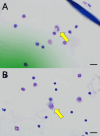A patient with P369S/R408Q variants in the MEFV gene presented with clinical features of Kikuchi disease and Mollaret meningitis, successfully treated with colchicine
- PMID: 39543514
- PMCID: PMC11562677
- DOI: 10.1186/s12883-024-03950-3
A patient with P369S/R408Q variants in the MEFV gene presented with clinical features of Kikuchi disease and Mollaret meningitis, successfully treated with colchicine
Abstract
Background: This case report presents the case of a patient with P369S and R408Q variants in the MEFV gene who exhibited clinical features of Kikuchi disease and Mollaret meningitis. Furthermore, it discusses colchicine as a new potential treatment option for Kikuchi disease-associated meningitis.
Case presentation: A 41-year-old Japanese woman presented with fever and headache. She had nuchal rigidity and bilateral cervical lymphadenopathies. Her past medical history included multiple episodes of aseptic meningitis and cervical lymphadenopathy for more than twenty years. Lumbar puncture showed increased lymphocytes and IL-6 level and pathognomonic Mollaret cells. Excisional lymph node biopsy revealed histiocytic necrotizing lymphadenitis, confirming the diagnosis of Kikuchi disease. Subsequently, her recurrent Kikuchi disease and meningitis were successfully treated with colchicine. Furthermore, genetic analysis of the MEFV gene revealed heterozygous P369S/R408Q variants in exon 3.
Conclusion: Mollaret meningitis can be associated with Kikuchi disease, and recurrence of both conditions may be suppressed by colchicine when these two coexist.
Keywords: MEFV; Colchicine; Familial mediterranean fever (FMF); Kikuchi disease.
© 2024. The Author(s).
Conflict of interest statement
Figures


References
-
- Bruyn GW, Straathof LJ, Raymakers GM. Mollaret’s meningitis. Differential diagnosis and diagnostic pitfalls. Neurology. 1962;12:745–53. 10.1212/wnl.12.11.745. - PubMed
-
- Lunardi P, Missori P. Cranial and spinal tumors with meningitic onset. Ital J Neurol Sci. 1990;11(2):145–51. 10.1007/BF02335557. - PubMed
Publication types
MeSH terms
Substances
LinkOut - more resources
Full Text Sources
Miscellaneous

